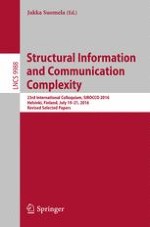2016 | Book
Structural Information and Communication Complexity
23rd International Colloquium, SIROCCO 2016, Helsinki, Finland, July 19-21, 2016, Revised Selected Papers
Editor: Jukka Suomela
Publisher: Springer International Publishing
Book Series : Lecture Notes in Computer Science
